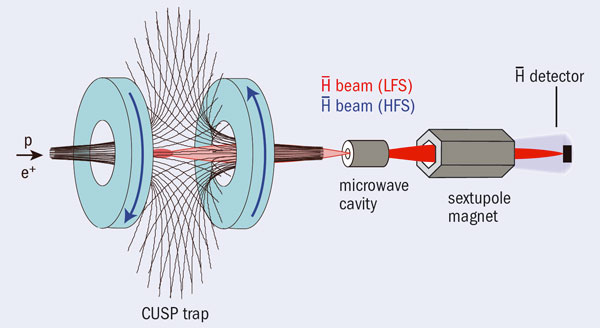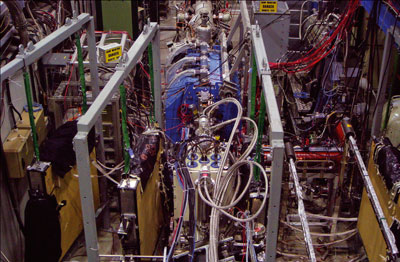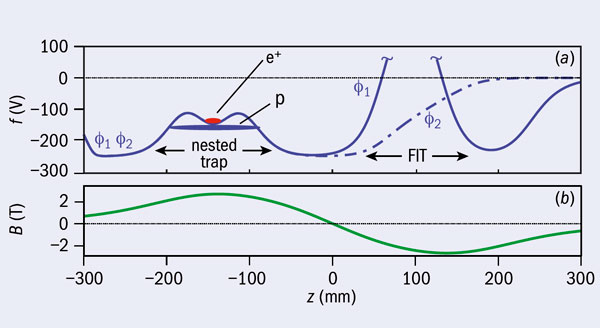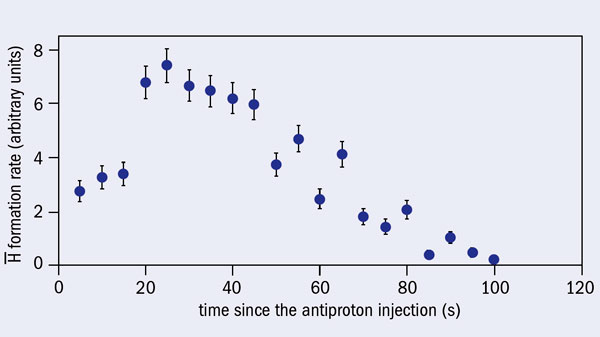Yasunori Yamazaki describes work towards an antihydrogen beam.

Image credit: ASACUSA.
Last December, the cusp-trap group of the Japanese–European ASACUSA collaboration demonstrated for the first time the efficient synthesis of antihydrogen, in a major step towards the production of a spin-polarized antihydrogen beam. Such a beam will allow, for the first time, high-precision microwave spectroscopy of ground-state hyperfine transitions in antihydrogen atoms, enabling tests of CPT symmetry (the combination of charge conjugation, C, parity, P, and time reversal, T) – the most fundamental symmetry of nature. The new experiment may also shed light on some of the most profound mysteries of our universe: the asymmetry of matter and antimatter in our universe. Why is it that the universe today is made up almost exclusively of matter, and not antimatter? Scientists believe that the answer may lie in tiny differences between the properties of matter and antimatter, manifested in violations of CPT symmetry.
Testing CPT symmetry
Antihydrogen, made up of an antiproton and a positron, is attractive for testing CPT symmetry given its simple structure. In particular, comparisons of antihydrogen’s transition frequencies with those of ordinary hydrogen atoms will provide stringent tests of CPT symmetry. For this purpose, the ATRAP and ALPHA experiments under way at CERN’s Antiproton Decelerator (AD) aim to make high-precision measurements of the transition frequency between the ground state (1s) and first excited state (2s) of antihydrogen, which is close to 2466 THz, in the realm of laser spectroscopy. The ALPHA collaboration made an essential breakthrough in this approach when they successfully trapped antihydrogen for the first time in November.
The ASACUSA experiment, also at the AD, is taking the complementary approach of measuring precisely the transition frequency between the two substates of the ground state that arise from hyperfine splitting as a result of the interaction between the two magnetic moments associated with the spins of the antiproton and the positron. The collaboration aims to measure the ground-state hyperfine transition frequency, which is about 1420 MHz in the microwave region, by extracting a spin-polarized antihydrogen beam in a field-free region. Last December, the cusp-trap group of ASACUSA reported that the cusp trap, which is designed not to trap antihydrogen but to concentrate spin-polarized antiatoms into a beam, succeeded in synthesizing antihydrogen atoms with an efficiency as high as 7%. This is a big step towards the realization of high-precision microwave spectroscopy of the ground-state hyperfine transition in antihydrogen.

The cusp trap uses anti-Helmholtz coils, which are like Helmholtz coils but with the excitation currents antiparallel rather than parallel to each other. This arrangement yields a magnetic quadrupole field that has axial symmetry about the coil axis: a so-called cusp magnetic field (figure 1). In addition, an axially symmetric electric field is generated by an assembly of multi-ring electrodes (MREs) that is coaxially arranged with respect to the coils. Having axial symmetry, these magnetic and electric fields guarantee the stable storage and manipulation of a large number of antiprotons and positrons simultaneously – one of the unique features of the cusp trap. Furthermore, the magnetic field distribution of the cusp trap can produce an intensified antihydrogen beam with high spin-polarization in low-field-seeking (LFS) states. In other words, antihydrogen atoms can be tested for CPT symmetry in a field-free (or weak field) region – a vital condition for making high-precision spectroscopy a reality. These properties are exclusive to the cusp-trap scheme.
As figure 1 shows, the extracted beam is injected into a microwave cavity, followed by a sextupole magnet and a spin analyser, and then focused on an antihydrogen detector (shown in red). When the microwave frequency is in resonance with one of the hyperfine transition frequencies, it induces a spin flip, which converts the LFS state into a high-field-seeking (HFS) state. In this case, the antihydrogen beam becomes defocused (shown in purple), a transition that is easily monitored by an intensity drop in the antihydrogen detector. As is evident from this description, the cusp trap scheme does not need to trap antihydrogen atoms, but it can do so if necessary. The big advantage is that a large number of antihydrogen atoms with higher temperatures can participate in the measurements.

Image credit: ASACUSA.
The AD at CERN supplies a pulsed antiproton beam of around 3 × 107 particles per pulse at 5.3 MeV, which is slowed down to 120 keV in ASACUSA by the radio-frequency quadrupole decelerator. For the antihydrogen experiments the beam is then injected into an antiproton catching trap (called the MUSASHI trap) through two layers of thin degrader foil. In this way, about 1.5 × 106 antiprotons per AD shot are accumulated in the trap where they are cooled with preloaded electrons. The antiproton cloud is then radially compressed by a “rotating wall” technique to allow efficient transportation into the cusp trap. The positrons that make up the antihydrogen are supplied via a compact all-in-one positron accumulator that was designed and developed for this research. Both antiprotons and positrons are then injected into the cusp trap to synthesize cold antihydrogen atoms. A 3D track detector monitors the cusp track to determine the annihilation position of antiprotons by tracking charged pions. The detector comprises two pairs of two modules, each with 64 horizontal and 64 vertical scintillator bars that are 1.5 cm wide.
Inside the cusp trap

Figure 2 shows schematically the structure of the central part of the cusp trap. The MRE is housed in a cryogenic ultrahigh vacuum tube held at a temperature of several Kelvin with a good heat contact, while still being insulated electrically. Thermal shields at 30 K located on both ends of the MRE prevent room-temperature radiation creeping in from the beamline. Outside the MRE part of the bore tube, five superconducting coils installed symmetrically with respect to the MRE centre provide the cusp magnetic field. On the downstream side, the bore diameter is expanded for efficient extraction of the antihydrogen beam.

In the recent experiment, antihydrogen atoms were synthesized by mixing antiprotons and positrons at the nested trap region, as shown by the blue solid line (φ1) in figure 3. As antihydrogen atoms are neutral, they are not trapped and move more or less freely so some of them reached the field-ionization trap (FIT). If the antihydrogen atoms were formed via a three-body-recombination process in high Rydberg states, i.e. relatively loosely bound, they are field-ionized and their antiprotons are accumulated in the FIT. During the experiment, the FIT was opened (as indicated by the dash dotted line, φ2) every 5 s and the antiprotons accumulated were released and counted by the 3D tracker through their annihilations. This gave the antihydrogen synthesis rate as a function of time since the start of the mixing process. Figure 4 shows an example of the evolution of the synthesis rate for 3 × 105 antiprotons and 3 × 106 positrons, in which the rate grew in the first 20–30 s, and then gradually decreased. In this case, a total of around 7 × 103 antihydrogen atoms were synthesized.

The ASACUSA collaboration is now looking forward to starting the microwave spectroscopy of hyperfine transition frequencies – which may lead to groundbreaking insights into the nature of antimatter and symmetry.





